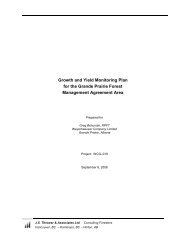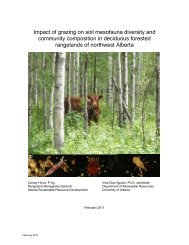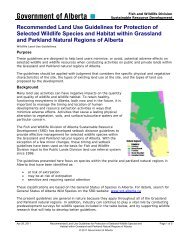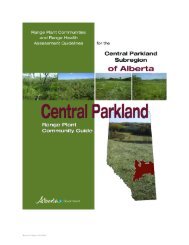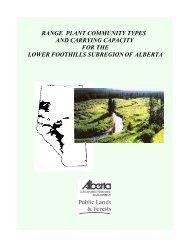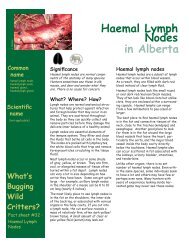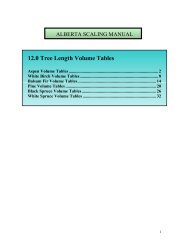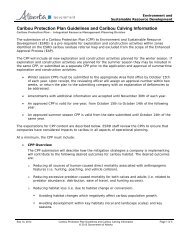Foothills Fescue Range Plant Community Guide - Sustainable ...
Foothills Fescue Range Plant Community Guide - Sustainable ...
Foothills Fescue Range Plant Community Guide - Sustainable ...
You also want an ePaper? Increase the reach of your titles
YUMPU automatically turns print PDFs into web optimized ePapers that Google loves.
communities is summarized on pages 31- 62. A total of 60 unclassified vegetation plots<br />
are summarized in Table 21 of Appendix 9.3. Owing to small sample size or<br />
unacceptable variability in the ordination Eigen values, the plots were not designated as<br />
plant communities in this approximation. As additional data become available, these<br />
unclassified plots will be reconsidered in future refinements of this guide.<br />
Reference plant communities and associated successional communities were defined for<br />
seven ecological range sites including wetland/subirrigated, four loamy types,<br />
gravel/shallow to gravel and thin breaks. The most significant of these are the three<br />
loamy types designated as loamy 1, 2 and 3 (Table 9).<br />
• The Loamy 1 plant community (FFA5) Rough <strong>Fescue</strong> - Parry Oatgrass, represents the<br />
moistest of upland loamy sites and is most common in the Willow Creek Upland.<br />
Historically, this type was likely extensive in the Delacour Plain, where only small<br />
remnant parcels of native grassland remain today. FFA5 is recognized by the<br />
presence of Parry oatgrass which may occur with or without Idaho fescue as a cosubdominant.<br />
• Loamy 2 (FFA2) Rough <strong>Fescue</strong> - Idaho <strong>Fescue</strong>, tends to occur in more southerly<br />
portions of the Willow Creek Upland and south to the US border. This type seems to<br />
define a north-south moisture gradient, with Parry oatgrass dropping out of the stand<br />
in the southern Porcupine Hills and Oldman river drainage in the Cardston Plain.<br />
• Loamy 3 (FFA1) is a dry loamy range sites and is found along the eastern boundary<br />
with the Mixedgrass Natural Subregion and the Milk River Ridge. The presence of<br />
Western wheatgrass signals the transition to the drier Mixedgrass prairie that adjoins<br />
the <strong>Foothills</strong> <strong>Fescue</strong> to the east.<br />
• Loamy 4 is a transition plant community (FFA24) to the Mixedgrass and is the driest<br />
of the loamy types.<br />
Gravel/shallow to gravel range sites are common in the Pekisko and Oldman drainages.<br />
Limy range sites are commonly found in the Cardston Plain and the Del Bonita Upland.<br />
While plant communities closely resemble a number of loamy types, subtle difference in<br />
subdominant species are evident and productivity for these sites is considerably lower<br />
than on loamy sites.<br />
Successional community types, where defined, are listed for each reference plant<br />
community in column three of the Table 9 and are ordered in descending successional<br />
ranking. <strong>Plant</strong> species changes for each plant community are described in the summary<br />
pages for each plant community. A significant feature of plant community changes, as<br />
disturbance increases, is the increase in non-native species like Kentucky bluegrass.<br />
27



